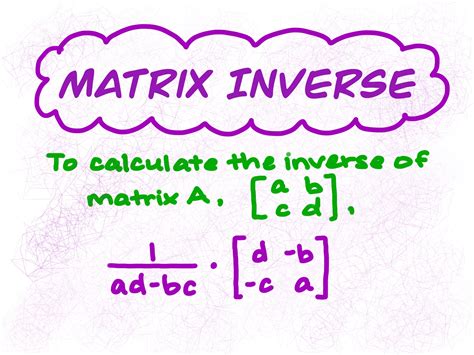Inverse Matrix Formula

The inverse of a matrix is a fundamental concept in linear algebra and has numerous applications in mathematics, physics, engineering, and computer science. In this article, we will delve into the intricacies of the inverse matrix formula, exploring its definition, properties, calculation methods, and practical examples. By understanding the inverse matrix formula, we can unlock powerful tools for solving systems of linear equations, analyzing geometric transformations, and performing advanced calculations in various fields.
Understanding the Inverse Matrix

In linear algebra, the inverse of a square matrix A is denoted as A-1 and represents a matrix that, when multiplied by the original matrix A, results in the identity matrix I. Mathematically, this relationship is expressed as:
\[ \begin{equation*} \mathbf{A}^{-1} \cdot \mathbf{A} = \mathbf{I} \, . \end{equation*} \]
The identity matrix I is a square matrix with ones on the main diagonal and zeros everywhere else. It serves as the multiplicative identity, meaning that when multiplied with any other square matrix of the same size, it leaves the matrix unchanged.
The existence of an inverse matrix is not guaranteed for all square matrices. A matrix must be invertible or non-singular to have an inverse. Invertible matrices have full rank, meaning their rows and columns are linearly independent. Matrices that are not invertible are called singular matrices.
The inverse of a matrix A is unique. If A-1 exists, it is the only matrix that satisfies the above equation. This property makes the inverse matrix a valuable tool for solving systems of linear equations and performing various mathematical operations.
Inverse Matrix Formula: Calculation Methods

Calculating the inverse of a matrix can be achieved using several methods, each with its own advantages and applicability. Here, we explore some of the commonly used techniques:
1. Gaussian Elimination and Inversion
Gaussian elimination is a systematic method for solving systems of linear equations. By applying row operations to a matrix, we can transform it into reduced row echelon form. The process of Gaussian elimination can also be used to find the inverse of a matrix. Here’s a step-by-step guide:
- Augment the original matrix A with the identity matrix I of the same size.
- Perform row operations (elementary row operations) to transform the left half of the augmented matrix into the identity matrix I.
- The right half of the augmented matrix after these row operations will be the inverse matrix A-1.
Gaussian elimination is a versatile method, but it can be computationally intensive for larger matrices. It is often more efficient to use other methods for inverse matrix calculation.
2. Adjugate Matrix Method
The adjugate matrix, often denoted as adj(A), is a matrix that plays a crucial role in calculating the inverse of a square matrix. The adjugate matrix is the transpose of the cofactor matrix, which is derived from the original matrix. To find the inverse using the adjugate matrix method, follow these steps:
- Calculate the adjugate matrix adj(A) by finding the transpose of the cofactor matrix of A.
- The inverse of A is given by A-1 = adj(A) / det(A), where det(A) represents the determinant of matrix A.
The adjugate matrix method is computationally efficient and provides a direct formula for calculating the inverse. However, it relies on the calculation of the determinant, which can be time-consuming for large matrices.
3. Matrix Exponential and Inverse
For certain types of matrices, particularly those with specific properties or structures, the inverse can be obtained using the matrix exponential function. The matrix exponential of a square matrix A is denoted as eA and can be defined using a power series expansion.
The inverse of a matrix A with certain properties can be expressed as:
\[ \begin{equation*} \mathbf{A}^{-1} = \frac{1}{\det(\mathbf{A})} \cdot \exp\left(-\mathbf{A}\right) \, . \end{equation*} \]
This method is particularly useful for matrices with special structures, such as diagonalizable matrices or matrices with specific patterns. It provides a compact and elegant way to compute the inverse.
4. LU Decomposition
LU decomposition is a factorization technique that breaks down a square matrix A into the product of a lower triangular matrix L and an upper triangular matrix U. The inverse of a matrix can be obtained using the following formula:
\[ \begin{equation*} \mathbf{A}^{-1} = \mathbf{U}^{-1} \cdot \mathbf{L}^{-1} \, . \end{equation*} \]
The LU decomposition method is computationally efficient and well-suited for numerical computations. It is widely used in scientific computing and engineering applications.
5. QR Decomposition
QR decomposition, also known as QR factorization, is another matrix decomposition technique that expresses a matrix as the product of an orthogonal matrix Q and an upper triangular matrix R. The inverse of a matrix can be computed using the QR decomposition as follows:
\[ \begin{equation*} \mathbf{A}^{-1} = \mathbf{R}^{-1} \cdot \mathbf{Q}^{-1} \, . \end{equation*} \]
QR decomposition is particularly useful for solving least squares problems and analyzing the stability of numerical algorithms. It is a powerful tool in computational linear algebra.
Properties and Applications of Inverse Matrices
Inverse matrices possess several important properties that make them valuable in various mathematical and scientific disciplines. Some key properties include:
- Uniqueness: As mentioned earlier, the inverse of a matrix is unique if it exists. This property ensures that the inverse is a well-defined mathematical object.
- Inverse of the Inverse: If A-1 is the inverse of matrix A, then A is also the inverse of A-1. This relationship can be expressed as A-1-1 = A.
- Inverse of a Product: The inverse of a product of two invertible matrices A and B is given by (AB)-1 = B-1A-1.
- Inverse of a Transpose: The inverse of the transpose of a matrix A is the same as the transpose of the inverse matrix, i.e., (AT)-1 = (A-1)T.
Inverse matrices find applications in a wide range of fields. Some notable applications include:
- Solving Systems of Linear Equations: Inverse matrices are essential for solving systems of linear equations. By multiplying both sides of the equation by the inverse of the coefficient matrix, we can obtain the solution vector.
- Geometric Transformations: Inverse matrices play a crucial role in describing and analyzing geometric transformations such as rotations, reflections, and shears. They allow us to reverse these transformations and perform inverse operations.
- Linear Regression and Least Squares: Inverse matrices are fundamental in linear regression analysis, where they help find the best-fit line or curve that minimizes the sum of squared residuals.
- Signal Processing and Filtering: Inverse matrices are used in signal processing algorithms, such as inverse filtering, to restore or enhance signals by removing noise or unwanted components.
- Computer Graphics and Animation: In computer graphics, inverse matrices are used for transforming objects, cameras, and lights, enabling realistic rendering and animation effects.
Practical Examples and Use Cases
To illustrate the practical applications of inverse matrices, let’s consider a few real-world examples:
Example 1: Image Processing
In image processing, inverse matrices are used to perform various operations, such as image restoration and enhancement. For instance, an image blurred by a known convolution matrix can be restored using the inverse of that matrix. By applying the inverse, the original sharp image can be recovered.
Example 2: Financial Modeling
Inverse matrices are crucial in financial modeling and analysis. They are used to calculate the inverse covariance matrix, which is essential for portfolio optimization and risk management. The inverse covariance matrix provides insights into the correlations and dependencies between different assets, helping investors make informed decisions.
Example 3: Computer Vision
Computer vision algorithms often involve the use of inverse matrices for various tasks. For example, in camera calibration, the inverse of the camera projection matrix is used to map image coordinates back to the 3D world coordinates. This process is vital for reconstructing 3D scenes from 2D images.
Example 4: Robotics and Control Systems
Inverse matrices are extensively used in robotics and control systems to perform inverse kinematics and dynamics calculations. By inverting the Jacobian matrix, which relates joint velocities to end-effector velocities, robots can compute the joint velocities required to achieve desired end-effector motions.
Conclusion

The inverse matrix formula is a powerful tool in linear algebra, enabling us to solve complex mathematical problems and perform advanced calculations in various fields. By understanding the properties and calculation methods of inverse matrices, we can leverage their capabilities to tackle real-world challenges in engineering, physics, computer science, and beyond. The applications of inverse matrices are vast and continue to drive innovation and progress in numerous scientific and technological domains.
What is the significance of an invertible matrix?
+An invertible matrix, also known as a non-singular matrix, has full rank, meaning its rows and columns are linearly independent. Invertible matrices have an inverse, which allows for solving systems of linear equations and performing various mathematical operations. They play a crucial role in many applications, including signal processing, computer graphics, and scientific computing.
Can all square matrices be inverted?
+No, not all square matrices are invertible. Singular matrices, which have a determinant of zero, cannot be inverted. These matrices lack full rank, meaning their rows and columns are linearly dependent. As a result, they do not have a unique inverse and cannot be used for solving systems of linear equations or performing certain mathematical operations.
How do you calculate the determinant of a matrix?
+The determinant of a square matrix can be calculated using various methods, such as expansion by minors, the Leibniz formula, or the Laplace expansion. The choice of method depends on the size and structure of the matrix. For larger matrices, computationally efficient algorithms, such as Gaussian elimination or LU decomposition, are often used to calculate the determinant.
What are the applications of inverse matrices in machine learning?
+Inverse matrices find applications in various machine learning algorithms. For example, in linear regression, the inverse of the covariance matrix is used to compute the weights of the linear model. In principal component analysis (PCA), the inverse of the covariance matrix is employed to project data onto a lower-dimensional space. Inverse matrices also play a role in optimization algorithms, such as Newton’s method, where the inverse of the Hessian matrix is utilized.



